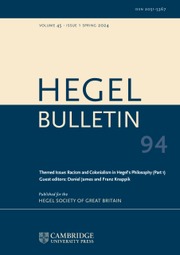No CrossRef data available.
Article contents
Thinking and Writing Truth. Rahel Levin Varnhagen's ‘Diaries’ and Philosophical Notes
Published online by Cambridge University Press: 01 July 2022
Abstract
This paper collects some of Rahel Levin Varnhagen's thinking about truth. It aims to contextualize Levin Varnhagen's non-conventional writing within German Romanticism. Her so-called ‘diaries’ vary between aphorisms, personal reflections, problem-oriented sketches and apodictic definitions concerning anthropology and society. Truth and honesty are shaped in opposition to lies but also build a base for the process of thinking itself. According to Levin Varnhagen, truth leads to the real quality of things and towards understanding—thinking truth is an epistemic process. The paper follows Levin Varnhagen's quest for and definition of truth by re-reading her diaries as philosophical practice. Thematizing the possibilities of critical female thought by a (Jewish) woman of the early nineteenth century (with a ‘twice incorrect name’, as Barbara Hahn has put it) and the restrictions in education and publishing, the paper addresses furthermore intersectional questions of gender and religion.
- Type
- Research Article
- Information
- Hegel Bulletin , Volume 43 , Special Issue 3: Women Philosophers in Hegel's Time , December 2022 , pp. 467 - 485
- Copyright
- Copyright © The Author(s), 2022. Published by Cambridge University Press on behalf of The Hegel Society of Great Britain



